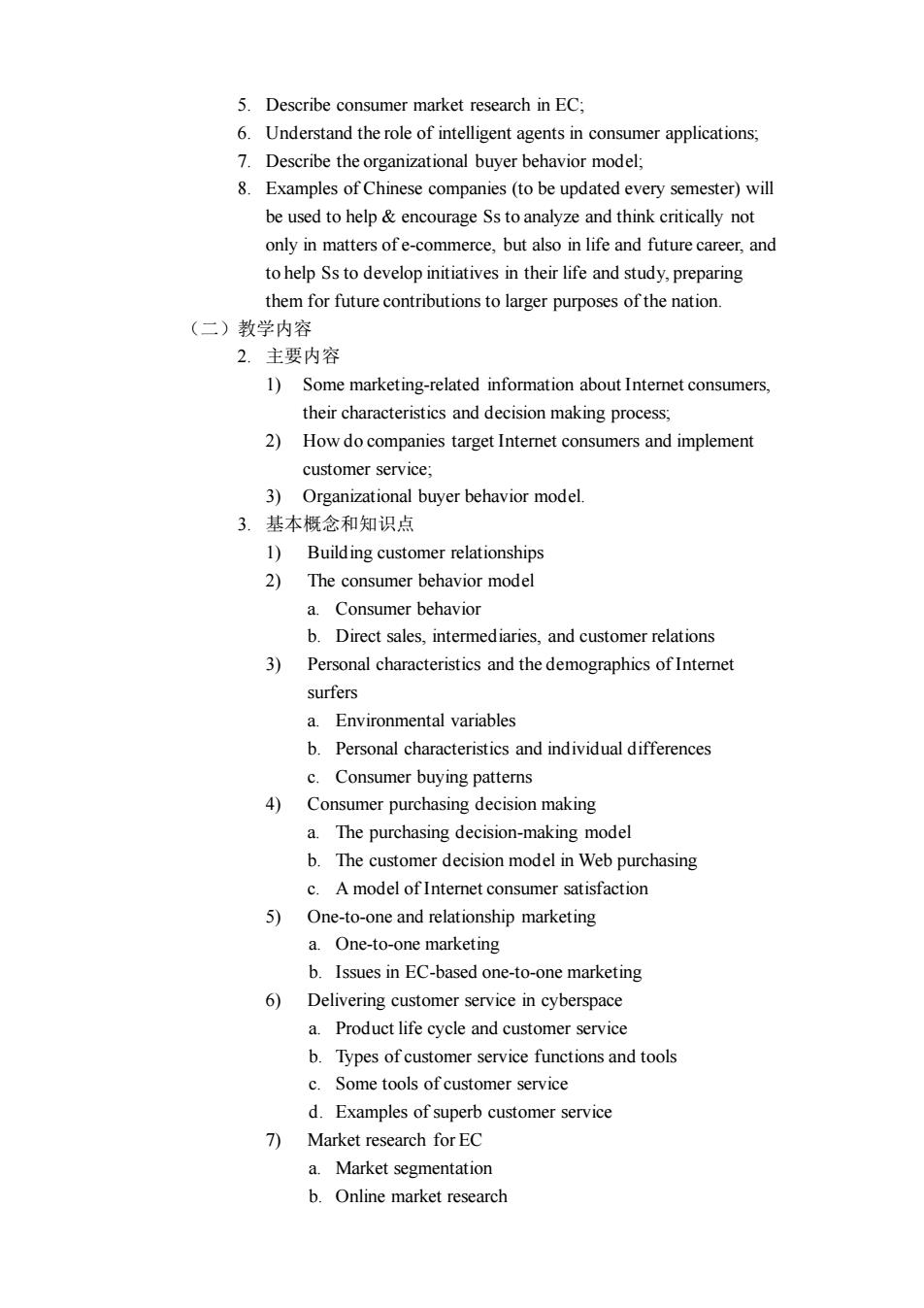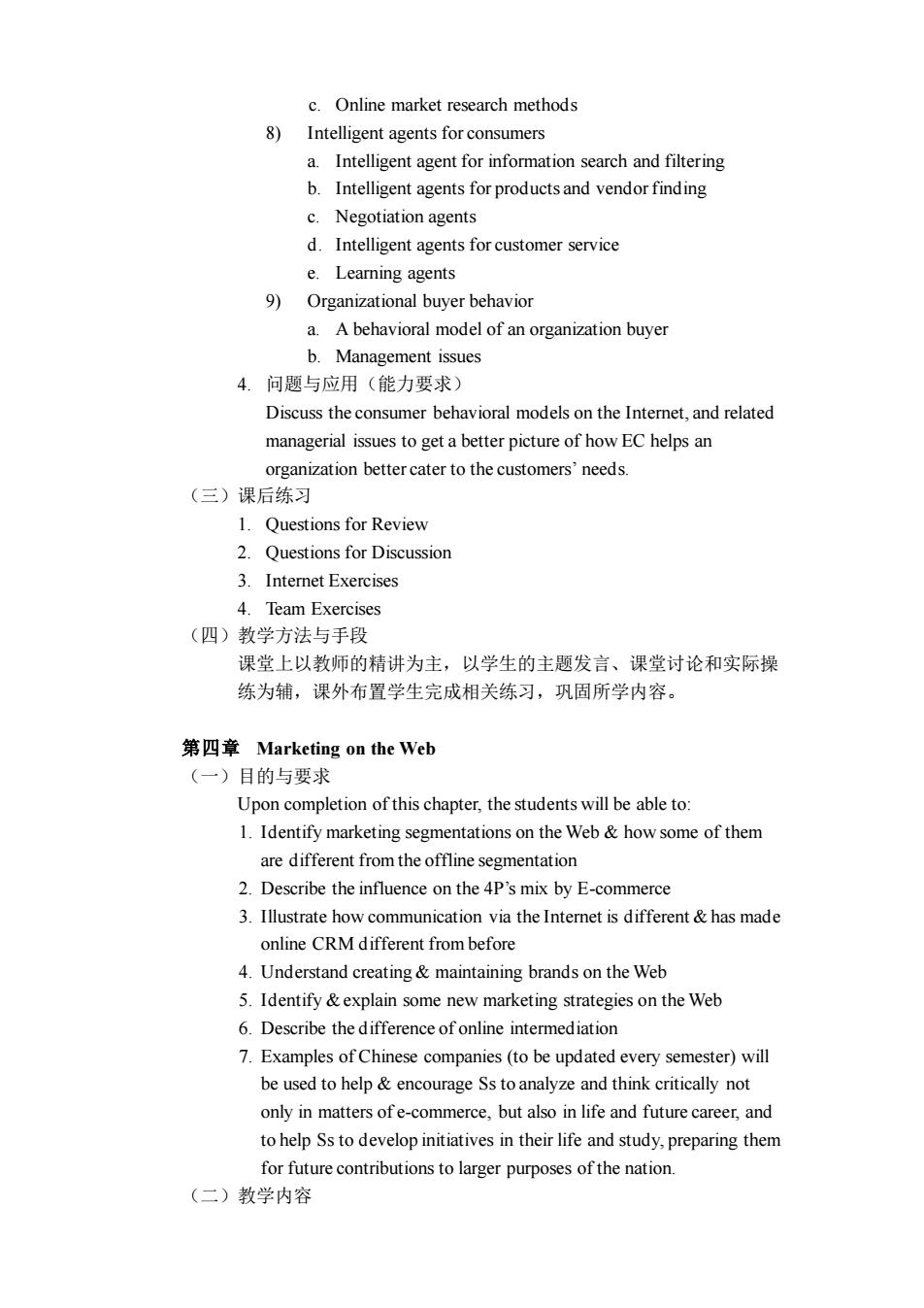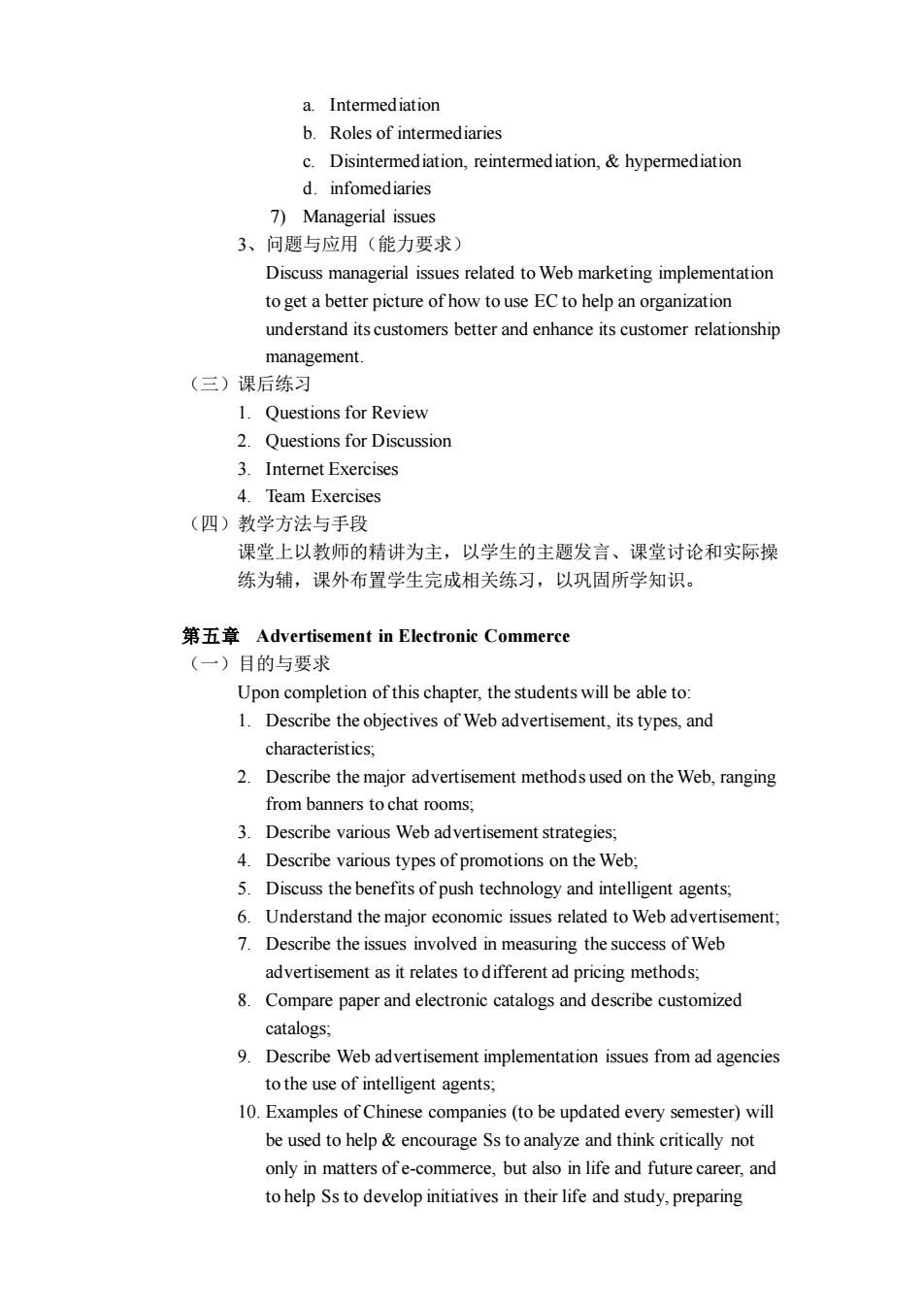
5.Describe consumer market research in EC. 6.Understand the role of intelligent agents in consumer applications, 7.Describe the organizational buyer behavior model; 8.Examples of Chinese companies (to be updated every semester)will be used to help&encourage Ss toanalyze and think critically not only in matters ofe-commerce,but also in life and future career,and tohelp Ss to develop initiatives in their life and study,preparing them for future contributions to larger purposes of the nation. (二)教学内容 2.主要内容 1)Some marketing-related information about Internet consumers their characteristics and decision making process; 2)How do companies target Internet consumers and implement customer service: 3) Organizational buyer behavior model 3.基本概念和知识点 1)Building customer relationships 2)The consumer behavior model a.Consumer behavior b.Direct sales,intermediaries,and customer relations 3)Personal characteristics and the demographics of Internet surfers a.Environmental variables b.Personal characteristics and individual differences c.Consumer buying patterns 4)Consumer purchasing decision making a.The purchasing decision-making model b.The customer decision model in Web purchasing c.A model ofInternet consumer satisfaction 5) One-to-one and relationship marketing a.One-to-one marketing b.Issues in EC-based one-to-one marketing 6)Delivering customer service in cyberspace a.Product life cycle and customer service b.Types of customer service functions and tools c.Some tools of customer service d.Examples of superb customer service Market research for EC a.Market segmentation b.Online market research
5. Describe consumer market research in EC; 6. Understand the role of intelligent agents in consumer applications; 7. Describe the organizational buyer behavior model; 8. Examples of Chinese companies (to be updated every semester) will be used to help & encourage Ss to analyze and think critically not only in matters of e-commerce, but also in life and future career, and to help Ss to develop initiatives in their life and study, preparing them for future contributions to larger purposes of the nation. (二)教学内容 2. 主要内容 1) Some marketing-related information about Internet consumers, their characteristics and decision making process; 2) How do companies target Internet consumers and implement customer service; 3) Organizational buyer behavior model. 3. 基本概念和知识点 1) Building customer relationships 2) The consumer behavior model a. Consumer behavior b. Direct sales, intermediaries, and customer relations 3) Personal characteristics and the demographics of Internet surfers a. Environmental variables b. Personal characteristics and individual differences c. Consumer buying patterns 4) Consumer purchasing decision making a. The purchasing decision-making model b. The customer decision model in Web purchasing c. A model of Internet consumer satisfaction 5) One-to-one and relationship marketing a. One-to-one marketing b. Issues in EC-based one-to-one marketing 6) Delivering customer service in cyberspace a. Product life cycle and customer service b. Types of customer service functions and tools c. Some tools of customer service d. Examples of superb customer service 7) Market research for EC a. Market segmentation b. Online market research

c.Online market research methods 8)Intelligent agents for consumers a.Intelligent agent for information search and filtering b.Intelligent agents for products and vendor finding c.Negotiation agents d.Intelligent agents for customer service e.Learning agents 9)Organizational buyer behavior a.A behavioral model of an organization buyer b.Management issues 4.问题与应用(能力要求) Discuss the consumer behavioral models on the Internet and related managerial issues to get a better picture of how EC helps an organization better cater to the customers'needs (三)课后练习 1.Questions for Review 2.Questions for Discussion 3.Internet Exercises 4.Team Exercises (四)教学方法与手段 课堂上以教师的精讲为主,以学生的主题发言、课堂讨论和实际操 练为辅,课外布置学生完成相关练习,巩固所学内容。 第四章Marketing on the Web (一)目的与要求 Upon completion of this chapter,the students will be able to 1.Identify marketing segmentations on the Web how some of them are different from the offline segmentation 2.Describe the influence on the 4P's mix by E-commerce 3.Illustrate how communication via the Intemnet is different&has made online CRM different from before 4.Understand creating&maintaining brands on the Web 5.Identify explain some new marketing strategies on the Web 6.Describe thedifference ofonline intermediation 7.Examples ofChinese companies(to be updated every semester)will be used to help&encourage Ss to analyze and think critically not only in matters ofe-commerce,but also in life and future career,and to help Ss to develop initiatives in their life and study,preparing them for future contributions to larger purposes of the nation. (二)教学内容
c. Online market research methods 8) Intelligent agents for consumers a. Intelligent agent for information search and filtering b. Intelligent agents for products and vendor finding c. Negotiation agents d. Intelligent agents for customer service e. Learning agents 9) Organizational buyer behavior a. A behavioral model of an organization buyer b. Management issues 4. 问题与应用(能力要求) Discuss the consumer behavioral models on the Internet, and related managerial issues to get a better picture of how EC helps an organization better cater to the customers’ needs. (三)课后练习 1. Questions for Review 2. Questions for Discussion 3. Internet Exercises 4. Team Exercises (四)教学方法与手段 课堂上以教师的精讲为主,以学生的主题发言、课堂讨论和实际操 练为辅,课外布置学生完成相关练习,巩固所学内容。 第四章 Marketing on the Web (一)目的与要求 Upon completion of this chapter, the students will be able to: 1. Identify marketing segmentations on the Web & how some of them are different from the offline segmentation 2. Describe the influence on the 4P’s mix by E-commerce 3. Illustrate how communication via the Internet is different & has made online CRM different from before 4. Understand creating & maintaining brands on the Web 5. Identify & explain some new marketing strategies on the Web 6. Describe the difference of online intermediation 7. Examples of Chinese companies (to be updated every semester) will be used to help & encourage Ss to analyze and think critically not only in matters of e-commerce, but also in life and future career, and to help Ss to develop initiatives in their life and study, preparing them for future contributions to larger purposes of the nation. (二)教学内容

1、主要内容 1)Marketing segmentations: 2)Marketing Mix and the 5th P. 3)Web communications how the Internet makes a difference for CRM: 4)Creating and maintaining brands on the Web; 5)New marketing opportunities&new marketing techniques 6)Intermediationon the Web 2、基本概念和知识点 1)Marketing segmentation a.Geographic segmentation b.Demographic segmentation c.Psychographic segmenatior d.Behavioral segmenation e.How segmentation is different online 2)Marketing Mix a.Product b.Price c.Place d Promotion e.How are the 4P's in Marketing Mix influenced by the Internet f.The 5th P--Personalization 3)Web communications a.Characteristics of web communications b.Implementing CRMon an enhanced communication medium c.Multi-step Flow Theory d.Social media marketing 4)Branding on the Web a.Creating a brand name on the Web 1)Emotional branding 2)Rational branding b.Maintaining brands on the Web 1)Brand leveraging strategies 2)Brand consolidation strategie 5)New marketing opportunities a.Seckill b.Collective buying 6)Intermediation on the Web
1、主要内容 1) Marketing segmentations; 2) Marketing Mix and the 5th P; 3) Web communications & how the Internet makes a difference for CRM; 4) Creating and maintaining brands on the Web; 5) New marketing opportunities & new marketing techniques. 6) Intermediation on the Web 2、基本概念和知识点 1) Marketing segmentation a. Geographic segmentation b. Demographic segmentation c. Psychographic segmenation d. Behavioral segmenation e. How segmentation is different online 2) Marketing Mix a. Product b. Price c. Place d. Promotion e. How are the 4P’s in Marketing Mix influenced by the Internet f. The 5th P -- Personalization 3) Web communications a. Characteristics of web communications b. Implementing CRM on an enhanced communication medium c. Multi-step Flow Theory d. Social media marketing 4) Branding on the Web a. Creating a brand name on the Web 1) Emotional branding 2) Rational branding b. Maintaining brands on the Web 1) Brand leveraging strategies 2) Brand consolidation strategies 5) New marketing opportunities a. Seckill b. Collective buying 6) Intermediation on the Web

a.Intermediation b roles of intermediaries c.Disintermediation,reintermediation,&hypermediation d.infomediaries 7)Managerial issues 3、问题与应用(能力要求) Discuss managerial issues related to Web marketing implementation to get a better picture of how to use EC to help an organization understand its customers better and enhance its customer relationship management (三)课后练习 1.Ouestions for Review 2.Questions for Discussion 3.Internet Exercises 4.Team Exercises (四)教学方法与手段 课堂上以教师的精讲为主,以学生的主题发言、课堂讨论和实际操 练为铺,课外布置学牛完成相关练习,以巩周所学知识。 第五章Advertisement in Electronic Commerce (一)目的与要求 Upon completion of this chapter,the students will be able to 1.Describe the objectives of Web advertisement,its types,and characteristics. 2.Describe the major advertisement methods used on the Web,ranging from banners to chat rooms: 3.Describe various Web advertisement strategies; 4.Describe various types ofpromotions on the Web 5.Discuss the benefits of push technology and intelligent agents; 6.Understand the major economic issues related to Web advertisement 7.Describe the issues involved in measuring the success of Web advertisement as it relates todifferent ad pricing methods. 8.Compare paper and electronic catalogs and describe customized catalogs, 9.Describe web advertisement implementation issues from ad agencies tothe use of intelligent agents, 10.Examples of Chinese companies(to be updated every semester)will be used to help encourage Ss to analyze and think critically not only in matters ofe-commerce.but also in life and future career,and to help Ss to develop initiatives in their life and study.preparing
a. Intermediation b. Roles of intermediaries c. Disintermediation, reintermediation, & hypermediation d. infomediaries 7) Managerial issues 3、问题与应用(能力要求) Discuss managerial issues related to Web marketing implementation to get a better picture of how to use EC to help an organization understand its customers better and enhance its customer relationship management. (三)课后练习 1. Questions for Review 2. Questions for Discussion 3. Internet Exercises 4. Team Exercises (四)教学方法与手段 课堂上以教师的精讲为主,以学生的主题发言、课堂讨论和实际操 练为辅,课外布置学生完成相关练习,以巩固所学知识。 第五章 Advertisement in Electronic Commerce (一)目的与要求 Upon completion of this chapter, the students will be able to: 1. Describe the objectives of Web advertisement, its types, and characteristics; 2. Describe the major advertisement methods used on the Web, ranging from banners to chat rooms; 3. Describe various Web advertisement strategies; 4. Describe various types of promotions on the Web; 5. Discuss the benefits of push technology and intelligent agents; 6. Understand the major economic issues related to Web advertisement; 7. Describe the issues involved in measuring the success of Web advertisement as it relates to different ad pricing methods; 8. Compare paper and electronic catalogs and describe customized catalogs; 9. Describe Web advertisement implementation issues from ad agencies to the use of intelligent agents; 10. Examples of Chinese companies (to be updated every semester) will be used to help & encourage Ss to analyze and think critically not only in matters of e-commerce, but also in life and future career, and to help Ss to develop initiatives in their life and study, preparing